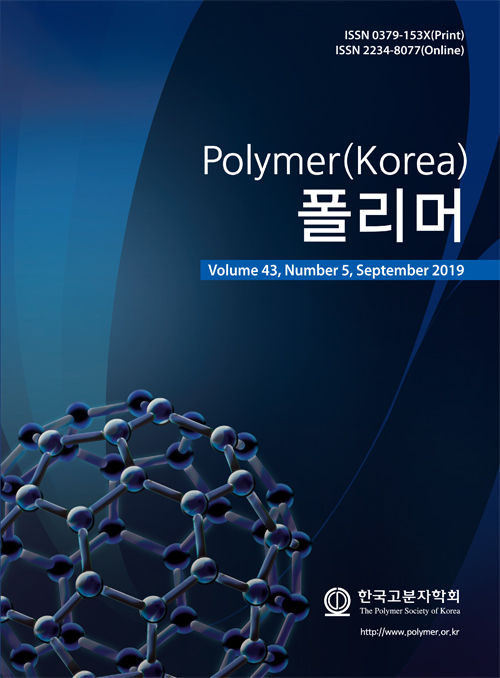- Synthesis of Polyurethane Elastomers by Different Kinds of Acids
*School of Energy, Materials and Chemical Engineering, Korea University of Technology and Education, Cheonan, Chungnam 31253, Korea
**Research Center of Eco-friendly & High Performance Chemical Materials, Cheonan, Chungnam 31253, Korea (Received May 1, 2019; Revised July 19, 2019; Accepted August 15, 2019)
- 산 종류에 따른 폴리우레탄 탄성체의 합성
*한국기술교육대학교 에너지, 신소재, 화학공학부, **친환경고성능화학소재연구소
Bio-polyester polyol was synthesized by using azelaic
acid, sebacic acid, succinic acid and 1,3-propanediol (1,3 PD).
4,4'-methylenebis(phenyl isocyanate) (MDI) was mixed in the ratio of 1:1.1
without chain extender to synthesize the bio-thermoplastic polyurethane (TPU).
Poly(1,4-butylene adipate) was used as polyol and MDI was mixed at the same ratio
to synthesize general TPU, and then physical properties were compared. FTIR,
TGA and GPC were used to analyze the composition and structure of the TPU. The
viscoelastic properties of the TPU were tested using the strain sweep function
of the rubber processing analyzer (RPA). The hardness, ball rebound and tensile
strength of the TPU were measured using a Shore A tester, ball rebound tester
and UTM. In addition, heat resistance, water resistance, and chemical
resistance were analyzed through the tensile strength retention ratio according
to external environment change. The bio-TPU with sebacic acid and 1,3-PD showed
the best viscoelastic and mechanical properties. The tensile strength was lower
than that of general TPU, but the retention ratio change was relatively high
according to the external environment.
Azelaic acid, sebacic acid,
succinic acid와
1,3-propanediol(1,3 PD)를 병용하여 바이오 폴리에스터 폴리올을 합성하였다. 합성한
폴리올에 사슬연장제 없이 MDI(4,4'-methylenebis(phenyl isocyanate))를 1:1.1 비율로 혼합하여 바이오 열가소성 폴리우레탄을 합성하였다.
Poly(1,4-butylene adipate)를 폴리올로 사용하여 같은 비율로 MDI를
혼합하여 일반 열가소성 폴리우레탄을 합성한 후 물성을 비교하였다. 열가소성 폴리우레탄의 성분 및 구조를
분석하기 위해서 FTIR, TGA 및 GPC를 사용하였다. 고분자가공분석기(RPA)의 변형 스윕(strain sweep) 기능을 이용하여 열가소성 폴리우레탄의 점탄성을 분석하였다. Shore A 경도계, 볼 반발 탄성시험기, UTM을 사용하여 열가소성 폴리우레탄의 경도, ball rebound, 인장강도를
측정하였다. 또한 외부 환경 변화에 따른 인장강도 유지율을 통해 내열성, 내수성, 내화학성을 분석하였다.
Sebacic acid와 1,3 PD에 의한 바이오 열가소성 폴리우레탄이 가장 좋은 점탄성과
기계적 물성을 보였다. 인장강도는 일반 열가소성 폴리우레탄에 비해 낮았지만, 외부 환경변화에 따른 유지율이 상대적으로 높았다.
Keywords: bio-polyurethane, bio-polyester polyol, vegetable oil, viscoelastic, mechanical properties
- Polymer(Korea) 폴리머
- Frequency : Bimonthly(odd)
ISSN 0379-153X(Print)
ISSN 2234-8077(Online)
Abbr. Polym. Korea - 2023 Impact Factor : 0.4
- Indexed in SCIE
 This Article
This Article
-
2019; 43(6): 824-830
Published online Nov 25, 2019
- 10.7317/pk.2019.43.6.824
- Received on May 1, 2019
- Revised on Jul 19, 2019
- Accepted on Aug 15, 2019
 Correspondence to
Correspondence to
- Ur Ryong Cho
-
*School of Energy, Materials and Chemical Engineering, Korea University of Technology and Education, Cheonan, Chungnam 31253, Korea
**Research Center of Eco-friendly & High Performance Chemical Materials, Cheonan, Chungnam 31253, Korea
- E-mail: urcho@koreatech.ac.kr










 Copyright(c) The Polymer Society of Korea. All right reserved.
Copyright(c) The Polymer Society of Korea. All right reserved.